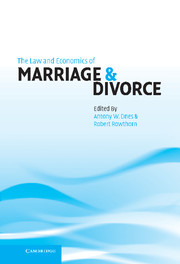Book contents
- Frontmatter
- Contents
- List of tables and figure
- List of contributors
- 1 Introduction
- 2 Marriage: the long-term contract
- 3 Marital commitment and the legal regulation of divorce
- 4 Mutual consent divorce
- 5 An economic approach to adultery law
- 6 Louisiana's covenant marriage law: recapturing the meaning of marriage for the sake of the children
- 7 Cohabitation and marriage
- 8 Marriage as a signal
- 9 For better or for worse? Is bargaining in marriage and divorce efficient?
- 10 Weak men and disorderly women: divorce and the division of labor
- 11 The impact of legal reforms on marriage and divorce
- 12 European divorce laws, divorce rates, and their consequences
- Index
- References
8 - Marriage as a signal
Published online by Cambridge University Press: 13 August 2009
- Frontmatter
- Contents
- List of tables and figure
- List of contributors
- 1 Introduction
- 2 Marriage: the long-term contract
- 3 Marital commitment and the legal regulation of divorce
- 4 Mutual consent divorce
- 5 An economic approach to adultery law
- 6 Louisiana's covenant marriage law: recapturing the meaning of marriage for the sake of the children
- 7 Cohabitation and marriage
- 8 Marriage as a signal
- 9 For better or for worse? Is bargaining in marriage and divorce efficient?
- 10 Weak men and disorderly women: divorce and the division of labor
- 11 The impact of legal reforms on marriage and divorce
- 12 European divorce laws, divorce rates, and their consequences
- Index
- References
Summary
Introduction
In Western countries, marriage is an institution for establishing a permanent and sexually exclusive union between a man and a woman, and for helping individuals to signal to each other and to the outside world their desire for such a union. The contractual aspects of marriage have been extensively analyzed in recent years from a law and economics perspective. There has been a prolonged debate about what type of contract is optimal and about the implications of various types of contract for marital behavior and divorce. However, apart from a brilliant, but neglected, paper by William Bishop and a handful of recent articles, the law and economics literature has been largely silent on the role of marriage as a signal.
The structure of this chapter is as follows. There is a brief discussion of the contractual basis of marriage and of some of the current proposals for reform in this area. There is then a section on the role of marriage as a signal. This includes a short exposition of the economic theory of signaling and an application of signaling theory to marriage. The chapter concludes by examining the implications for government policy towards cohabitation and same sex marriage.
Marriage as a contract
The original emphasis in the law and economics literature was on the “traditional” family, in which a mother stays at home to look after the children while the father earns money outside to support his dependants.
- Type
- Chapter
- Information
- The Law and Economics of Marriage and Divorce , pp. 132 - 156Publisher: Cambridge University PressPrint publication year: 2002
References
- 12
- Cited by



